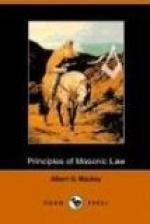The next general assemblage of the craft, of which the records of Freemasonry inform us, was that convened in 926, at the city of York, in England, by Prince Edwin, the brother of King Athelstane, and the grandson of Alfred the Great. This, we say, was the next general assemblage, because the Ashmole manuscript, which was destroyed at the revival of Freemasonry in 1717, is said to have stated that, at that time, the Prince obtained from his brother, the king, a permission for the craft “to hold a yearly communication and a general assembly.” The fact that such a power of meeting was then granted, is conclusive that it did not before exist: and would seem to prove that the assemblies of the craft, authorised by the charter of Carausius, had long since ceased to be held. This yearly communication did not, however, constitute, at least in the sense we now understand it, a Grand Lodge. The name given to it was that of the “General Assembly of Masons.” It was not restricted, as now, to the Masters and Wardens of the subordinate lodges, acting in the capacity of delegates or representatives, but was composed, as Preston has observed, of as many of the fraternity at large as, being within a convenient distance, could attend once or twice a year, under the auspices of one general head, who was elected and installed at one of these meetings, and who, for the time being, received homage as the governor of the whole body. Any Brethren who were competent to discharge the duty, were allowed, by the regulations of the Order, to open and hold lodges at their discretion, at such times and places as were most convenient to them, and without the necessity of what we now call a Warrant of Constitution, and then and there to initiate members into the Order.[5] To the General Assembly, however, all the craft, without distinction, were permitted to repair; each Mason present was entitled to take part in the deliberations, and the rules and regulations enacted were the result of the votes of the whole body. The General Assembly was, in fact, precisely similar to those political congregations which, in our modern phraseology, we term “mass meetings.”
These annual mass meetings or General Assemblies continued to be held, for many centuries after their first establishment, at the city of York, and were, during all that period, the supreme judicatory of the fraternity. There are frequent references to the annual assemblies of Freemasons in public documents. The preamble to an act passed in 1425, during the reign of Henry VI., just five centuries after the meeting at York, states that, “by the yearly congregations and confederacies made by the Masons in their general assemblies, the good course and effect of the statute of laborers were openly violated and broken.” This act which forbade such meetings, was, however, never put in force; for an old record, quoted in the Book of Constitutions, speaks of the Brotherhood having frequented this “mutual assembly,” in




